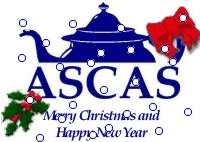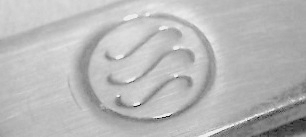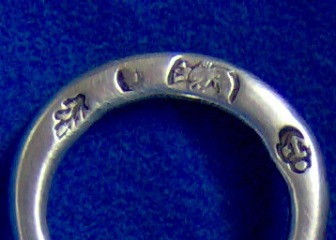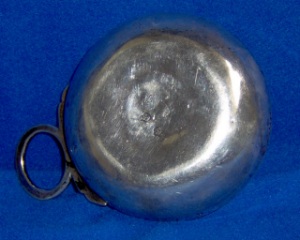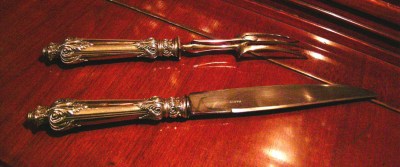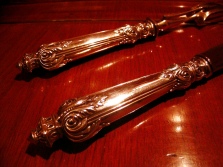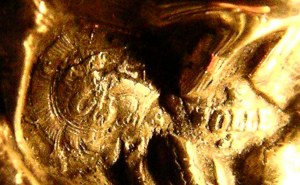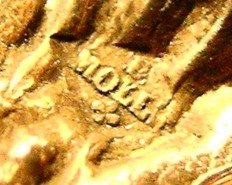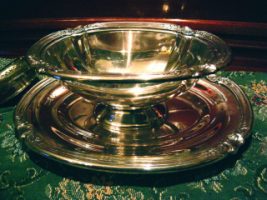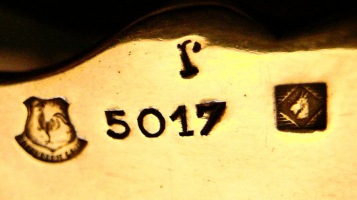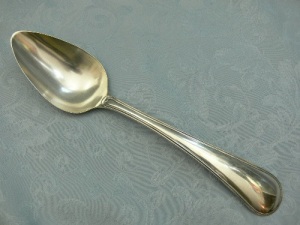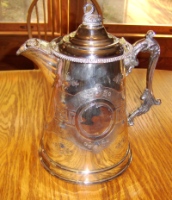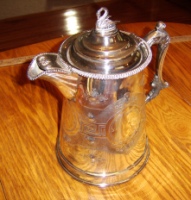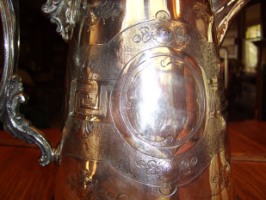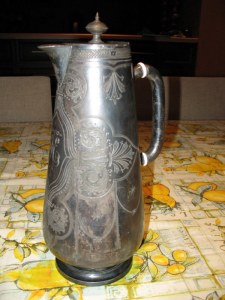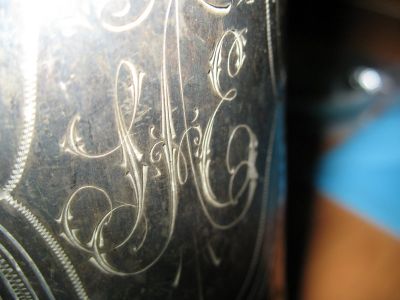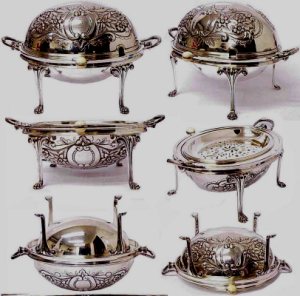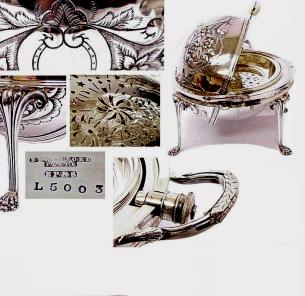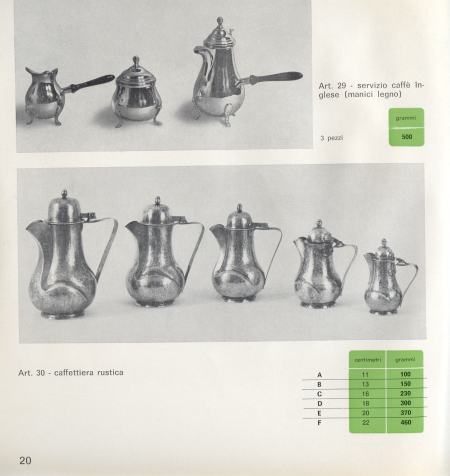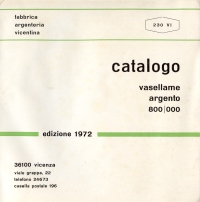 newsletter # 32 - December 2006
newsletter # 32 - December 2006www.ASCASonline.org
email: silverassociation@yahoo.it
YOUR GUIDE TO THE DECEMBER NEWSLETTER:
articles new members
members' window
|
2007 ASCAS membership
No fees are requested nor accepted for ASCAS membership.
Members still interested to ASCAS and its activity are invited
to send an e-mail to
confirming their 2007 membership (the simplest way is to
use the 'reply' button on our December e-mail).
I apogize for this little effort requested to whomever
appreciates and supports ASCAS activity.
No action is requested to unsubscribe. Members not confirming
their membership will be automatically deleted and shipping of
our monthly Newsletter will be suspended on February
2007.
Giorgio Busetto
ASCAS Secretary
Two new articles for ASCAS website
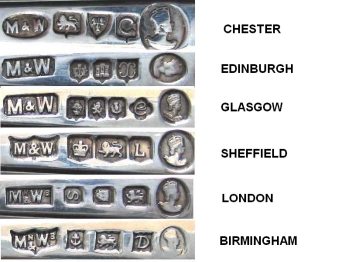
Giovanni Ciceri presents: |
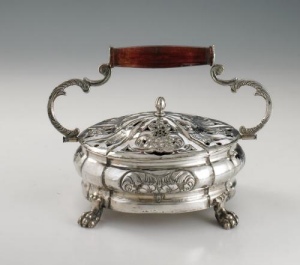 Giorgio Busetto presents:
Giorgio Busetto presents:A forgotten object: the silver warmer Un oggetto di cui si è dimenticato l'uso: lo scaldino d'argento When central heating was not available, besides stove and fireplace, another heating item was used in ancient times: the warmer (or brazier). It was a container in metal, terracotta or ceramic filled with embers and warm ash used as personal heating support and bed warming. The female custom to hold the warmer next to the body or under the garment is the origin of the popular Dutch belief that women could be made pregnant simply by holding the warmer on their womb..... click here |
New members
Welcome to new ASCAS members:
Glenn R. Davis - USA
Hamid Ghambarezade - Iran
Leslie Gray - England UK
Annie Keogh - England UK
Thomas E. Marshall - USA
Govinda Overcash - USA
Silvia Perini - Italy
Joette Pierce - USA
Ginny Riley - USA
Juan Alfonso Samayoa Azmitia Guatemala
Glenn Shearer - USA
Delia Sinden - England UK
Suzanne Young - Canada
Members' Window # 32
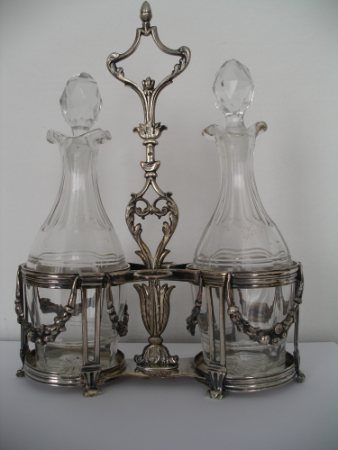 Attilio Porsia and Giorgio
Busetto present:
Attilio Porsia and Giorgio
Busetto present:A collection of silver and crystal cruet stands Una collezione di oliere in argento e cristallo tra '700 e '800 The Italian, French and "Continental" tradition refers to "cruet stand" as the oil and vinegar container, sometimes with salt and pepper shakers, rarely accompanied by spice, mustard or other condiment casters, bottles and jars..... click here |
Mail to ASCAS: e-mail
silverassociation@yahoo.it
An appeal by Karin Sixl-Daniell:
Has any ASCAS member seen an example of a cutlery set made by the firm of Hermann Ratzersdorfer of Vienna? A publication just mentioning one would be of assistance alsoHermann Ratzersdorfer is a 19th century Viennese silversmith,
Karin is working on research about a cutlery set of
this silversmith
Giorgio Busetto
ASCAS Secretary
Mario Nuvolari writes:
recently bought a silver "tastevin" (wine taster) ; it is supposed to be
French (XVIII century?) and it bears these marks (see photos).
Can anyone help me to identify them?
Thank you
Mario Nuvolari
Alessandro Colemann writes:
I have a pair of pieces that I'd wish to know more about:
a serving set with French hallmark and a four-leaf clover and
E:MOLLE into a lozenge.
Thank you in advance
Alessandro Colemann
The maker of your set is:
Edmond Molle - 114 Rue du Temple Paris
registered 11 May 1898 and cancelled 25 September 1919
I hope that ASCAS mambers will be able to identify the mark of
the silver plate sauce boat
Renée Watkins writes:
I have recently purchased 4 Sterling serving spoons. They are
stamped with the marks attached. I have not been able to
identify the marks and would very much appreciate your help.
Renée Watkins
Your spoon was made in Holland in 1867.
I publish Renée's question and I hope that ASCAS members can
identify the maker.
Giorgio
Mike Dawson writes:
... I stumbled across your site looking for a way to identify
a pitcher that has been in my family for over 150 years. I'm not
looking for a price, just an id. I can't find any marks on it
that would help someone like me (clueless). I'm doing a research
paper on it and having some information on how and where it was
produced would greatly help me.
Mike Dawson
In absence of any mark it's very difficult to identify the
origin of a silver object. I trust in ASCAS members for some
useful suggestions for your research.
Giorgio Busetto
Hamid Ghanbarezade writes:
... I send you some photos of my teapot marked SB&M.
I hope you may help me identifying the maker. I think it isn't
silver but silverplate, but I'd wish to know something more
about its history.
In Iran antique is very much, and silver and silver plate of
Russian origin is available. I'd need information about "norblin"
-- "Galw"-- "warsowa" marks
Thank you in advance
Hamid Ghanbarezade
Ginny Riley writes:
... I am trying to identify a Austrian silversmith who worked
after 1922 for a friend. So unfortunately the CD-Rom on
'Viennese gold- and silversmiths from 1781 and 1921 would not
help in this task.
I have attached a photo of the hallmark.
The first mark is one used in Austria since 1922.
The "" stands for the city of Vienna.
That's a toucan head in the center.
The "4" on the right stands for a silver purity of .750.
However the middle hallmark appears to be 800 with a period at
the top.
I do not know if this signifies 800 silver or is another mark?
And the last mark is JxH.
If you have any information on this maker, I would be very
grateful.
Ginny Riley
Replies to questions
Jaquie Mallory of the Soo Line Historical Museum wrote on
November Newsletter:
... I have a burning question for you.... My board of
directors is worried about the constant polishing of our
collection. We use Silvo silver polish, and they are worried
with the polishing all of the time that we will be getting down
to the copper below, on some of the artifacts. Are you aware of
a product that helps keep the shine longer? We have a number of
airtight cabinets - that can go 3 years or so without cleaning.
However we have pieces that sit out that need constant cleaning.
I have 2 elderly volunteers who just slather on the Silvo, and
like to polish alot! So I was just curious if you had any
information ....
Thank You !!
Jaquie receives these replies to her appeal:
Ian Cook writes:
I may have the answer for the question posed by Jacquie in
November Newsletter regarding polish. I use GODDARD'S Long
Term Silver Polish and have found that it's 'long term'
protective properties are exceedingly good. The formulation,
while providing excellent cleaning properties, also inhibits
retarnishing. I have found that the lustre and shine remains for
much longer than the results produced by other cleaners.
Additionally, the Company also produces a polishing cloth that,
when used in conjunction with the liquid polish will maintain
that 'just polished look'. For ornate piece's it is recommended
to rinse the polish off rather than rub.
The products are widely available in the UK, but I am not to
sure about Internationally!
Best Regards
Ian COOK
Lloyd Prator writes:
I am always reluctant to polish electroplated wares too
vigorously or frequently. Repeated polishing will, indeed, wear
away the silver and expose the base metal. While I don't collect
plated wares, I use Haggerty's silver wash on things which need
frequent polishing. It seems to be a less aggressive form of
silver polish. Better to put the things under glass and use
Haggerty's anti-tarnish paper strips to keep them shining.
Lloyd Prator
Maja Heynecke writes:
If there are items in our house that we have standing out,
and the way we keep them clean is by washing them fairly often
in dishwashing liquid that has lemon as one of the ingredients.
This keeps the items fairly clean, and it keeps them polished
and sparkling for much longer without having to polish them, and
is not as corrosive as Silvo polish or similar.
Sometimes I rub some of my more marked and blackened silver
items with a lemon and leave it to stand for a few minutes
before rinsing them off with dishwashing liquid, which works
very well.
Maja HEYNECKE
Jayne W. Dye writes:
This URL is an excellent article for Jackie Mallory of the Soo Line Museum. For your Board and your volunteers: Print the entire article found at www.bishopmuseum.org
(click here). You are right to be concerned. The situation you describe might be handled by a silver cloth only, if cleaning is weekly, and the cleaners should wear soft cotton gloves. Next safest, with less frequent cleaning, might be a bit of a 'dip' product on a cotton ball, passed lightly over the surface then followed by a gentle wash and then the silver cloth. Silvo is mentioned as a good product; rubbing is mentioned as harmful. Do read the entire article.Jayne W. Dye
| Fred Lange
receives this reply about his item
( see November Newsletter) Maja Heynecke writes: Fred, your silver piece looks like a butter or
caviar dish. The rolltop is quite common in caviar
dishes, and it would have a glass dish inside it, with
ice underneath the silver lining. The mark is not so
clear, but it doesn't look like a reproduction to me. I
can't make out the mark. Beresford?
|
|||
Carole McKillop-Mash receives this reply about her "Chinese" bowl: ( see November Newsletter) Hymie Dinerstein writes: The Chinese marks are possibly the marks of 'Chewshing'
and the Chinese marks possibly Jui Chi. The Dutch small
coffee spoons copies with pseudo Dutch marks of which
there are over 615 fake or pseudo marks that I have
found and they were probably made sometime after 1890.
Beware of these fake marks as at a quick glance,
sometime they are quite similar to original marks
especially on apostle spoons.
|
|||
Michael Blake writes about the mysterious hallmarks of his coffee pot on #26 June 2006 Newsletter: ( see June Newsletter) ...Just a note to let you know that my infamous Coffee/Chocolate pot (see
June/July Newsletters) has been assessed by the London
Assay Office and found to be a duty dodger.
|
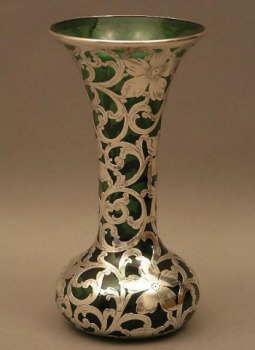
|
SILVER "OVERLAY" GLASSSilver has been used to decorate bronze, copper, and earthenware for ages. Silver on glass, however, started to come into its own a little over a century ago.In 1889 Oscar Pierre Erard of Birmingham, England, developed an effective method of electroplating silver on glass and porcelain. Although beautiful on the outside, it shared an important shortcoming with its predecessors. The reverse side of the silver design, the side next to the glass would tarnish and turn dark..... more |
Closing our DECEMBER 2006 edition of ASCAS Newsletter I hope you have appreciated its content.
Your comments, suggestions and advice will be of great help.
My thanks to Michael Blake (England UK), Giovanni Ciceri (Italy), Alessandro Colemann (Italy), Ian Cook (England UK), Mike Dawson, Hymie Dinerstein (England UK), Jayne Dye (USA), Hamid Ghanbarezade (Iran), Maja Heynecke (South Africa), Mario Nuvolari (Italy), Attilio Porsia (Italy), Lloyd Prator (USA), Ginny Riley (USA), Karin Sixl-Daniell (Austria), Renée Watkins (Canada), for their invaluable contributions.
Giorgio Busetto
Secretary
ASCAS is a community of people having a
common interest in antique silver.
|
